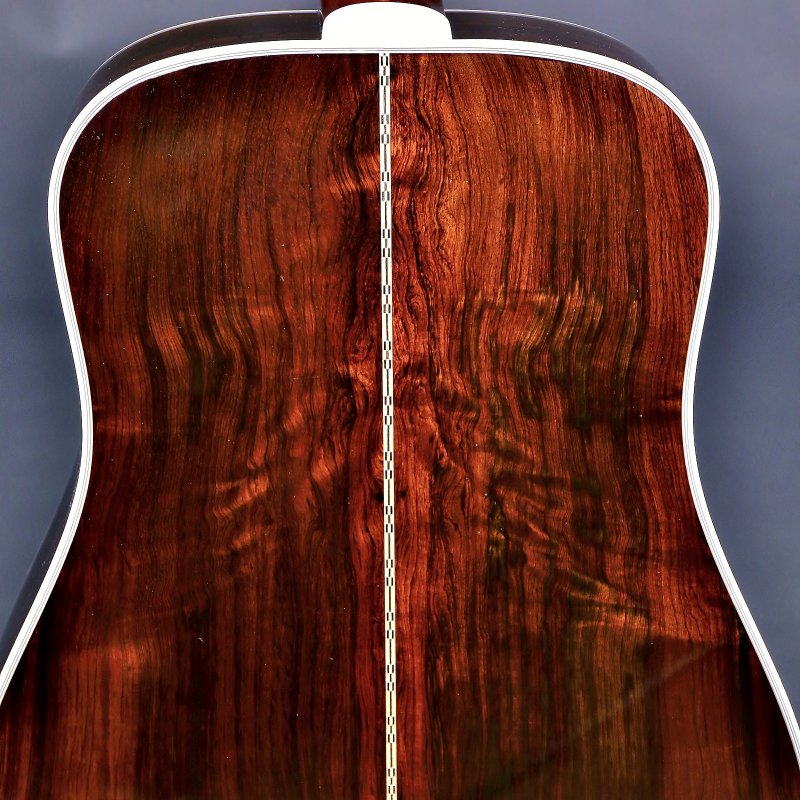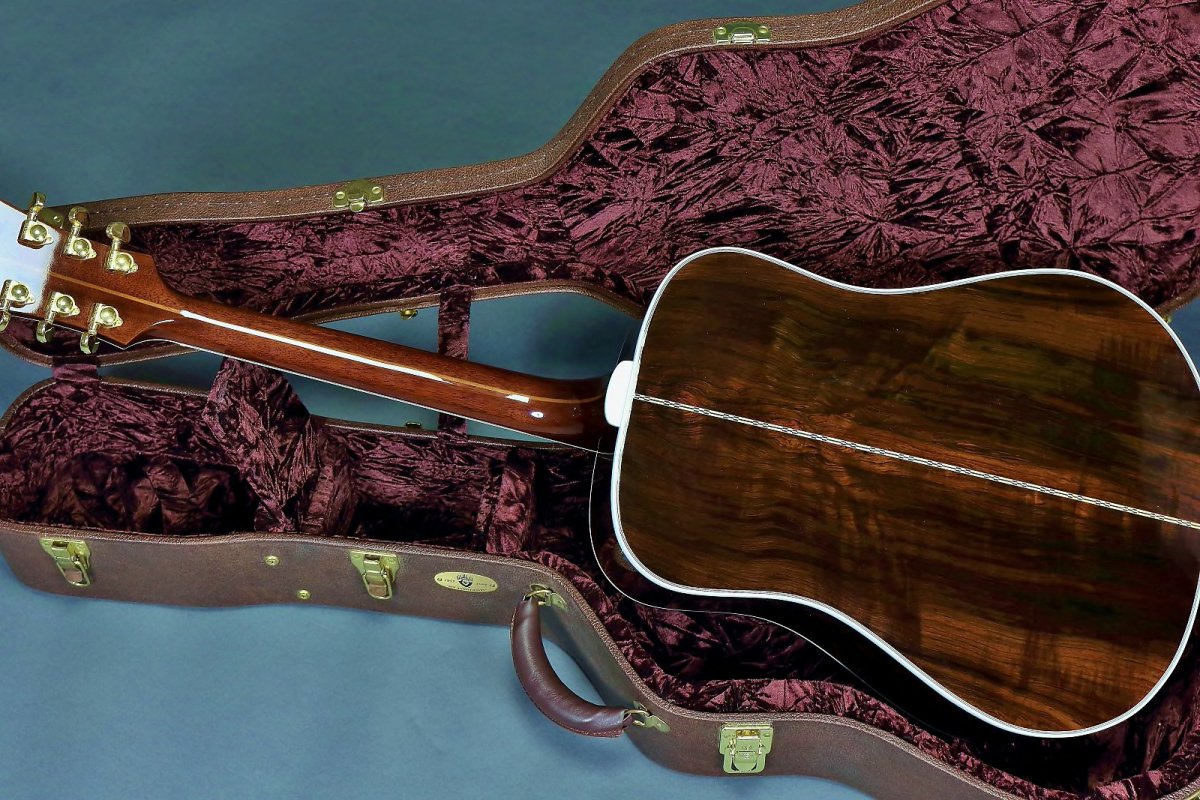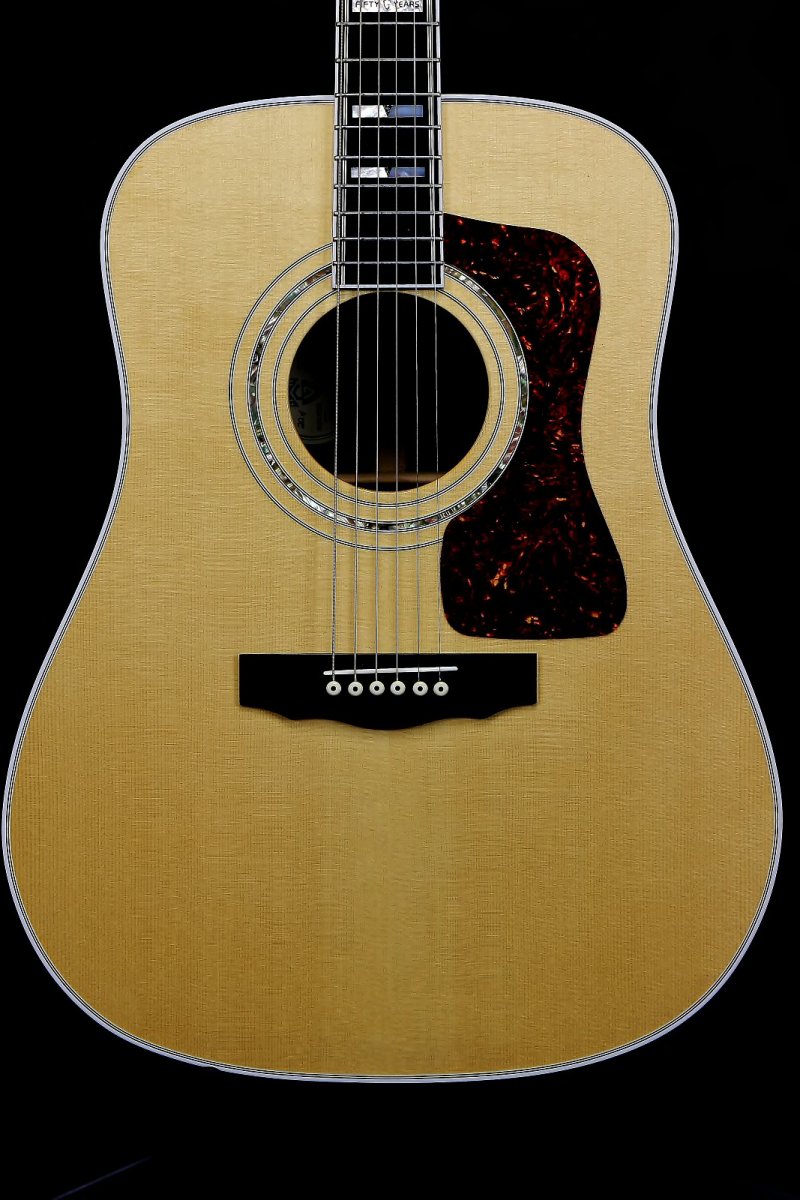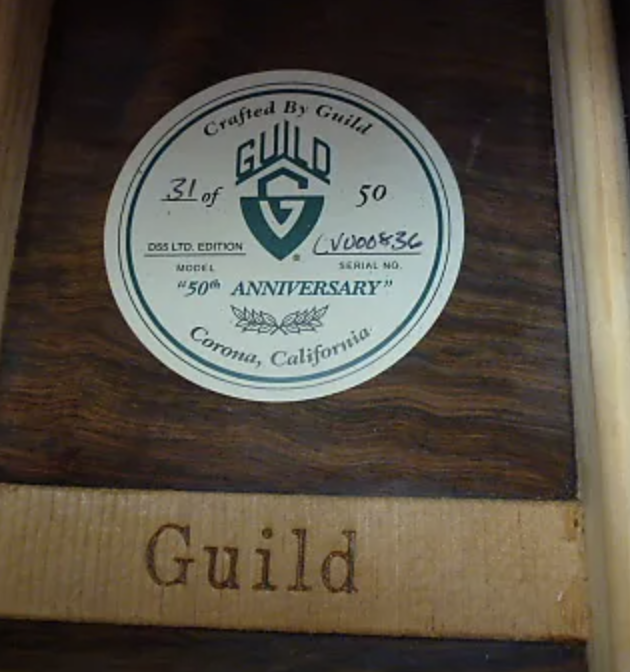You are using an out of date browser. It may not display this or other websites correctly.
You should upgrade or use an alternative browser.
You should upgrade or use an alternative browser.
Brazilian Rosewood of the Guild D-55 50th Anniversary
- Thread starter AoxoA
- Start date
SFIV1967
Venerated Member
That kind of detail might have been discussed here previsouly, in the meantime that is the little info the press release said:
"January 22, 2003
American guitar manufacturer, Guild Guitars, will enjoy a very special 50th anniversary this year, and kicked off it's year-long celebration at this winter's NAMM show with the introduction of the Anniversary Model D-55. Production of this guitar is limited to fifty pieces.
While the Guild Guitar Company was "officially" conceived in 1952, it wasn't until 1953 when its very first guitars were finished and ready for delivery. Since that time, Guild has become the number one choice in archtop jazz guitars the world over, with its acoustic and electric guitars holding their own place in popular music history. From Johnny Smith to Muddy Waters, from Howlin' Wolf to Ritchie Havens and from Jimmy Bruno to Slash, Guild guitars have helped shape the sounds of jazz, blues and rock as we know it today.
To commemorate this historic milestone, Guild will honor its most recognized and most popular acoustic guitar, the D-55. The new Anniversary Model D-55 is built at Guild's state-of-the-art manufacturing facility in Corona, California, and uses only the world's finest guitar making materials.
Four-A grade highly figured Brazilian rosewood has been selected for the back and sides of the guitar, with master grade Engleman spruce for its top. The body, neck and headstock are feature a cream binding, with abalone block inlays featured on the fretboard and traditional abalone Guild logo on the headstock. A special 12th fret abalone inlay and engraved truss rod cover both signify the 50th Anniversary.
The prototype 50th Anniversary Model Guild was on display at Guild's NAMM booth. Only fifty more pieces will ever be reproduced, and they are available on a per-order basis. US MSRP is $5,500.00."
Ralf
"January 22, 2003
American guitar manufacturer, Guild Guitars, will enjoy a very special 50th anniversary this year, and kicked off it's year-long celebration at this winter's NAMM show with the introduction of the Anniversary Model D-55. Production of this guitar is limited to fifty pieces.
While the Guild Guitar Company was "officially" conceived in 1952, it wasn't until 1953 when its very first guitars were finished and ready for delivery. Since that time, Guild has become the number one choice in archtop jazz guitars the world over, with its acoustic and electric guitars holding their own place in popular music history. From Johnny Smith to Muddy Waters, from Howlin' Wolf to Ritchie Havens and from Jimmy Bruno to Slash, Guild guitars have helped shape the sounds of jazz, blues and rock as we know it today.
To commemorate this historic milestone, Guild will honor its most recognized and most popular acoustic guitar, the D-55. The new Anniversary Model D-55 is built at Guild's state-of-the-art manufacturing facility in Corona, California, and uses only the world's finest guitar making materials.
Four-A grade highly figured Brazilian rosewood has been selected for the back and sides of the guitar, with master grade Engleman spruce for its top. The body, neck and headstock are feature a cream binding, with abalone block inlays featured on the fretboard and traditional abalone Guild logo on the headstock. A special 12th fret abalone inlay and engraved truss rod cover both signify the 50th Anniversary.
The prototype 50th Anniversary Model Guild was on display at Guild's NAMM booth. Only fifty more pieces will ever be reproduced, and they are available on a per-order basis. US MSRP is $5,500.00."
Ralf
I'm not sure if you can tell how it was sawn, AoxoA. The grain seems to run (relatively) straight from top to bottom. But, clearly, the log that it was cut from had lots of imperfections that gave it that neat figuring with the quilt and puckering. I'm not even sure if you can say that it's from a stump or perhaps the grain was affected by a branch growing in that area.What do y'all know about the Brazilian Rosewood used for the D-55 50th Anniversary? Is it quartersawn or flatsawn? Stumpwood or not? How old was it? I read it was from a 1950’s pre embargo stash.
Anyway, we do know from the records (as Ralf posted) that it's recognized to be Brazilian rosewood. Where the log/flitch came from or whether Corona just bought a bunch of cut sets is not something I recall discussing here. I know I saw the small stash of Brazilian sets that New Hartford had 10 years later, and that may have sourced back to Corona, but I think (not at all sure) that it came from Tacoma.
I'd love to see pictures of the Engelmann spruce top if you can do that sometime!
AoxoA
Junior Member
The 50th anniversary press release states the AAAA grade and highly figured. The grading breaks down as follows:
"AAAAA" master
"AAAA" best
"AAA" better
"AA" good
"A" okay
I read that the above ratings are based on how well it is quarter sawn and the aesthetics or visual appearance.
I also read that figured BRW could be either quartersawn (QS) or flat sawn--it's not necessarily tied to the cut. Highly figured could mean the curly figure of stumpwood (localized grain distortion) or pigment figure (landscaping or spiderwebbing). So, we can’t necessarily determine how it was cut based on it being highly figured. John Arnold, a professional luthier, mentioned in an Acoustic Guitar Forum post that most stumpwood cut for guitars is QS. And again in another forum, “The two important points about stumpwood are that it is primarily cut with guitars in mind, meaning that the straighter-grained wood is used for the sides. and nearly all of it I have seen is QS."
Maybe it is safe to assume the wood is most likely quartersawn....
But was it stumpwood? Most U.S. guitar manufacturers stopped using the BRW in the late 1960s. Was stumpwood used before that?
Things people say about stumpwood is interesting. Those old growth trees reached heights of well over 100 feet with trunk diameters of more than 3 feet. Supposedly, many of those stumps are 4-5 feet tall, and the set sawn from the top of the stump could be wood that grew immediately adjacent to a set that went into a Martin guitar in the 1930's when the tree was harvested.
All the hearsay is interesting to me….stumpwood, how it was cut, how long ago was it harvested, etc….
"AAAAA" master
"AAAA" best
"AAA" better
"AA" good
"A" okay
I read that the above ratings are based on how well it is quarter sawn and the aesthetics or visual appearance.
I also read that figured BRW could be either quartersawn (QS) or flat sawn--it's not necessarily tied to the cut. Highly figured could mean the curly figure of stumpwood (localized grain distortion) or pigment figure (landscaping or spiderwebbing). So, we can’t necessarily determine how it was cut based on it being highly figured. John Arnold, a professional luthier, mentioned in an Acoustic Guitar Forum post that most stumpwood cut for guitars is QS. And again in another forum, “The two important points about stumpwood are that it is primarily cut with guitars in mind, meaning that the straighter-grained wood is used for the sides. and nearly all of it I have seen is QS."
Maybe it is safe to assume the wood is most likely quartersawn....
But was it stumpwood? Most U.S. guitar manufacturers stopped using the BRW in the late 1960s. Was stumpwood used before that?
Things people say about stumpwood is interesting. Those old growth trees reached heights of well over 100 feet with trunk diameters of more than 3 feet. Supposedly, many of those stumps are 4-5 feet tall, and the set sawn from the top of the stump could be wood that grew immediately adjacent to a set that went into a Martin guitar in the 1930's when the tree was harvested.
All the hearsay is interesting to me….stumpwood, how it was cut, how long ago was it harvested, etc….
Last edited:
AoxoA
Junior Member
I'd love to see pictures of the Engelmann spruce top if you can do that sometime!
Attachments
Now that's what I'm talkin' about! Beautiful, beautiful top!
AoxoA
Junior Member
Engelmann Spruce (Picea englemannii) is native to western North America. That's all I know about it so far. It will be the next thing to look into.Now that's what I'm talkin' about! Beautiful, beautiful top!
Rich Cohen
Senior Member
I have owned one. Wasn't particularly impressed with the tone, sustain.
AoxoA
Junior Member
I wonder why some are and some aren't.I have owned one. Wasn't particularly impressed with the tone, sustain.
geoguy
Senior Member
Could be as simple as an irregular bottom on a saddle (or saddle slot), or a not-so-rigid shim beneath a saddle. Or something more nuanced re: the woods used in a particular example, or the way it was assembled. Or ill-suited strings.
I've had two used guitars that sounded especially bad, that came back to life after removing a soft-plastic saddle shim from one instrument, & installing lighter-gauge strings on the other. Was very surprised by the improvement in sound (at least to my ears) in both cases.
I've had two used guitars that sounded especially bad, that came back to life after removing a soft-plastic saddle shim from one instrument, & installing lighter-gauge strings on the other. Was very surprised by the improvement in sound (at least to my ears) in both cases.
AoxoA
Junior Member
.....these 50th Anniversary D55's are built so tough I don't think the "Stable" issue really matters. They are much more robust than your early 60's Guild D40 build. Mine is a wonderful guitar and one of the best sounding Dreads I have ever played of any Brand. The craftsmanship is second to none and the tone is truly representative of the classic Brazilian "Grand Piano" tone. This one should make someone extremely happy!
Had one right when they were released but had to sell it. Wish I had not. One of the most enjoyable guitars I have ever played.
So many variables at play @geoguy !! Most everyone that writes about the 50th Anniversary D55 has great things to say, aside from complaining about the price.
But the differences in opinion on whether or not the tone or sustain impresses kinda circles back to helping me learn about Brazilian Rosewood. They say nice sound isn’t determined by the cut (quartersawn or flat sawn). "Some woods are stiffer when QS, but BR is not one of them." It appears that stumpwood sets, like log sets, have to be judged individually like any other tonewood.
I found a few members who think they were stumpwood (from the post here and here).
Looks like quarter sawed stump Braz.
It does look like stump wood..... so beautiful. That wood is abstract enough for me to get a little crazy about the whole thing!! WOW!!
Yes, it is stump wood. That doesn't preclude it being old growth though (the stumps are usually the oldest parts of the tree). It also doesn't preclude it from sounding good; you won't know until you hear it.
At this point, I am assuming the 50th annv. BRW was quartersawn, stumpwood. Still interested to know any more opinions of the 50th Anniversary's Brazilian being from stumpwood or not? And how old the stash might have been?
Last edited:
bobouz
Senior Member
- Joined
- Jan 29, 2015
- Messages
- 2,273
- Reaction score
- 1,875
Yes indeed. One of the first things I do with a guitar is to pull the saddle & do whatever is required to assure it is optionally set in the slot. Additionally, a change to Tusq is often in order, as it is my preferred material for its bright & punchy qualities. Case in point: I’ll never forget how the tone of my G-37 received a total makeover, just by changing out the saddle & setting it properly.Could be as simple as an irregular bottom on a saddle (or saddle slot), or a not-so-rigid shim beneath a saddle. Or something more nuanced re: the woods used in a particular example, or the way it was assembled. Or ill-suited strings.
I've had two used guitars that sounded especially bad, that came back to life after removing a soft-plastic saddle shim from one instrument, & installing lighter-gauge strings on the other. Was very surprised by the improvement in sound (at least to my ears) in both cases.
Rayk
Enlightened Member
- Joined
- Apr 19, 2015
- Messages
- 5,793
- Reaction score
- 1,201
How many of these were made ? I know I’m walking the proverbial cliff edge again . I wouldn’t expect Guild to have used stump wood and that doesn’t look like the stump cuts I’ve seen but grain of salt there .
If I’m not wrong they still export some Brazilian we know old stock is or was grandfathered in so to say but also natural storm fall trees still can be harvested .
There’s more than few Luthiers out there that seem to continually build with it .
Engalmann !? Ugh I’d B slap that guys decision on choice of top for this guitar ! Besides glamour I’ve not played one Engalmann top that’s worth a hoot .
Its low head room is a poor choice for a dread . It’s proclaimed sweetness and detail for fingerpicking is well , bland but that’s just my experience. I heard some demos that come across well in vids etc and fully know that a luthiers can do wonders but it’s hit or miss . EQ’n mixes does wonders to .
And at this point I am turning tail and running away !


If I’m not wrong they still export some Brazilian we know old stock is or was grandfathered in so to say but also natural storm fall trees still can be harvested .
There’s more than few Luthiers out there that seem to continually build with it .
Engalmann !? Ugh I’d B slap that guys decision on choice of top for this guitar ! Besides glamour I’ve not played one Engalmann top that’s worth a hoot .
Its low head room is a poor choice for a dread . It’s proclaimed sweetness and detail for fingerpicking is well , bland but that’s just my experience. I heard some demos that come across well in vids etc and fully know that a luthiers can do wonders but it’s hit or miss . EQ’n mixes does wonders to .
And at this point I am turning tail and running away !
The press release said limited to 50, Ray. Fender probably would've had the wherewithal to source Brazilian for 50 bodies, but my guess is that less were actually built. Just a guess, though.How many of these were made ?
I don't know if Brazil can actually export their rosewood anymore, but there is plenty of guitar wood still available out there. Lots of the independent luthiers have their own stashes that they've collected or bought from each other.If I’m not wrong they still export some Brazilian we know old stock is or was grandfathered in
I think the soundboard on my Ibanez AW-75 is Engelmann, and that guitar is a lifelong companion of mine. Sings beautifully . But, yeah, it's not that commonly used and I agree with you that there are plenty of other spruces I'd rather have. It sure looks beautiful, though... Which, of course, is a key eye-candy factor, especially for an anniversary edition. Plus, it always looks new/fresh because it doesn't seem to darken like, say, Sitka.Engalmann !? Ugh I’d B slap that guys decision on choice of top for this guitar ! Besides glamour I’ve not played one Engalmann top that’s worth a hoot .
luthiers can do wonders but it’s hit or miss

SFIV1967
Venerated Member
I can't remember a picture of 50 of 50. Not even sure what the highest number is we saw. In theory there would have beenFender probably would've had the wherewithal to source Brazilian for 50 bodies, but my guess is that less were actually built. Just a guess, though.
Ralf
Last edited:
Bill Ashton
Senior Member
- Joined
- Sep 29, 2006
- Messages
- 4,435
- Reaction score
- 1,042
- Location
- North Central Massachusetts
- Guild Total
- 4
Italian flatpicking guitarist Beppe Gambetta owns two R Taylor mini-jumbos (?), top with Engleman, body/sides of "Madi" Rosewood. I have only heard 1, but there is no lack of sustain in that combo or build. Will ask him about his second when I see him in June.
Just as another comment, again maybe not germain to the discussion, while at Kaufman Kamp last year I had the chance to play another attendee's H & D dreadnaught, similar to mine but weighted a ton! Like playing a Les Paul! It was Brazilian Rosewood. Looked pretty, sounded about like mine (EIR and torrified adi top)...
Just as another comment, again maybe not germain to the discussion, while at Kaufman Kamp last year I had the chance to play another attendee's H & D dreadnaught, similar to mine but weighted a ton! Like playing a Les Paul! It was Brazilian Rosewood. Looked pretty, sounded about like mine (EIR and torrified adi top)...
Those R. Taylors were nice guitars.Italian flatpicking guitarist Beppe Gambetta owns two R Taylor mini-jumbos (?), top with Engleman, body/sides of "Madi" Rosewood. I have only heard 1, but there is no lack of sustain in that combo or build. Will ask him about his second when I see him in June.
Just as another comment, again maybe not germain to the discussion, while at Kaufman Kamp last year I had the chance to play another attendee's H & D dreadnaught, similar to mine but weighted a ton! Like playing a Les Paul! It was Brazilian Rosewood. Looked pretty, sounded about like mine (EIR and torrified adi top)...
AoxoA
Junior Member
How many of these were made ?
That Brazilian Rosewood was used for a limited edition run of 50 guitars along with at least two prototypes; The NAMM prototype (headstock was stamped with P 000001) and one that didn’t have anything stamped on the headstock (pics here and here talked about here).I can't remember a picture of 50 of 50. Not even sure what the highest number is we saw. In theory there would have been 51 because there was the additional NAMM 2003 prototype (as also mentioned in the press release) that was not part of the 50 counted.
In theory 52 of 50th anniversary D55s with Brazilian Rosewood back and sides (50 production, 2 prototypes).
@SFIV1967 I have seen pics of #31 of 50 (attached). So, I assume there are at least 31 production builds and 2 prototypes. There are not many "modern" D55 guitars that are made with Brazilian Rosewood for back and sides. The 50th Anniversary and the Merlefest Brazilian D-55 may have been the last.
Reportedly, there are only three other Modern Guilds that were made with Brazilian RW Back and sides.
1979 would be East Indian Rosewood. I have seen some regular production Guilds as late as 1970 made with Brazilian RW Back and sides but most of that was phased out and changed to East Indian RW back and sides during the late 60's. There was a short period in the 70's where Guild had some nicely figured East Indian Rosewood and used it on D50's among other models. I have seen people misidentify that Figured EIR as Brazilian but it is EIR none the less. Guild did use Brazilian RW for Bridges and Fretboards well into the 70's to use up their stock that they already had on hand but pieces big enough for back and sides were all pretty much gone by 1970.
Guild did however produce a 50th Anniversary 2003 D55 model that was limited to 50 guitars that had Brazilian RW back and sides. There are only three other Modern Guilds that I know of that were made with Brazilian RW Back and sides. One was made around 2003 by Master builder Chris Fleming out of the Corona Custom shop which I own and it is a F47 model. The other two I know of were made during the Tacoma, Wa. era in the F47 body style and one was given to Matt Umanov of Umanov Guitars in NY by Fender. The other went to a High up Fender Exec from what I have heard. Hope that info helps and Welcome to LTG!
Attachments
Last edited:
SFIV1967
Venerated Member
Oh, you are right! 2 prototypes! 2015, no wonder I couldn't remember that discussion! I had seen the real #1 in San Jose many years ago. So bad those photos are gone in that old discussion.along with at least two prototypes; The NAMM prototype (headstock was stamped with P 000001) and one that didn’t have anything stamped on the headstock (pics here and here talked about here).
Ralf



